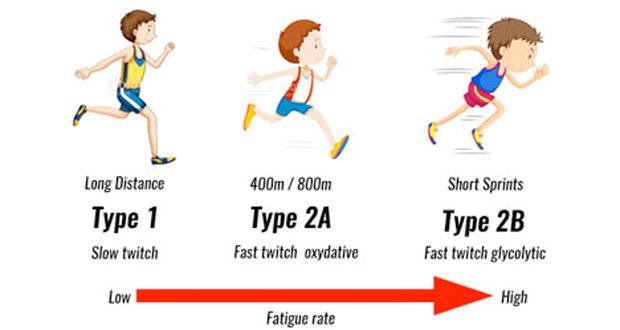Skeletal muscle is comprised of packs of individual muscle fibres called
myocytes. Each myocyte contains numerous myofibrils, which are strands of
proteins (actin and myosin) that can take hold of one another and pull, similar
action to the inner and outer part of a piston. This shortens the muscle and
causes muscle contraction.
It is commonly acknowledged that muscle fibre types can be separated into
two primary sorts: slow twitch (type I) muscle fibres and fast twitch (type
II) muscle fibres.1 fast twitch fibres can be additionally arranged into
type 2a and type 2b fibres .
Slow Twitch Muscle Fibres (Type I)
The slow twitch muscle fibres are efficient when utilizing oxygen (aerobic) to use the
fuel adenosine triphosphate (ATP) for sustained energy and increased number of
muscle contractions over quite a while. They fire more gradually than fast twitch
strands and can go for quite a while before they fatigue. Consequently, slow twitch
fibres are used for endurance / repetitive contractions like competitors who run
long-distance races and bike for hours.
Fast Twitch Muscle Fibres (Type 2)
Since fast twitch strands work anaerobically (without oxygen) to use adenosine
triphosphate (ATP) fuel, they are better at producing short bursts of movement or
speed than slow twitch fibres. In any case, they fatigue more rapidly. Fast twitch
strands for the most part produce a similar level of power per contraction as slow
twitch fibres, however, they get their name since they can fire more quickly.
Having faster twitch strands can be an advantage for a runner since there is a need
to rapidly create a high force.
FastTwitch Muscle Fibres (Type 2a)
These fast twitch muscle fibres are otherwise called middle of the road fast
twitch strands. They can utilize both high-impact and anaerobic digestion
similarly to make energy. Along these lines, they are a mix of type I and
type II muscle strands.
Fast Twitch Muscle Fibres (Type 2b)
These fast twitch strands work anaerobically to produce contraction and
are the muscle fibres that produce higher power
per contraction creating quick, amazing explosions of speed. This muscle fibre
has the most elevated speed of contraction (quick terminating) of all the muscle
fibre types, yet it likewise has a quicker point of fatigue and can’t keep
going as well before it needs rest.
Training of muscles
When you’re training with loads including resistance of movement, you will likely
recruit as many fibres as could reasonably be expected within the muscle.
Training the body to more effectively recruit its muscle fibres reflects in more
prominent gains in quality and muscle mass.
In the event that your strands in a specific muscle comprise principally of
slow twitch fibres, so as to recruit the most muscle fibres, you’ll have to train that
muscle with higher reps, shorter rest periods and higher volume. This is on the
grounds that they take more time to fatigue, they recover rapidly and they require
more training to improve significantly.
Conversely, slow twitch muscle fibres are limited in their potential
for development so regardless of whether a muscle bunch is a fundamentally
slow twitch, you should incorporate some lower rep training to improve the fast
twitch strands you have in that muscle.



